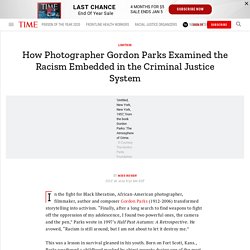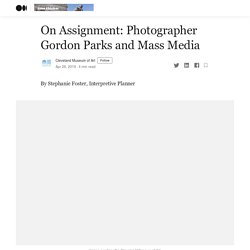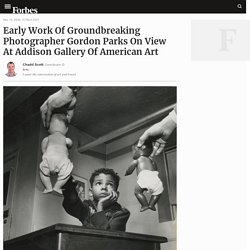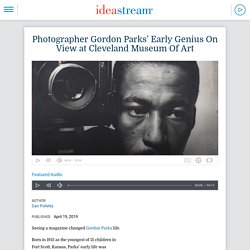

The early work of groundbreaking photojournalist Gordon Parks – in pictures. How photographer Gordon Parks became an essential witness to the injustices of Jim Crow. Gordon Parks: The Crime Photographer Who Saw Color. Photography: The Atmosphere of Crime, 1957, by Gordon Parks, published by Steidl In 1957, Life magazine sent one of its star photographers on a sprawling assignment: six weeks in four of America’s biggest cities to capture scenes of urban crime.

The photographer was Gordon Parks, for 20 years the only black photographer on Life’s staff, and he later described the assignment like this: “I rode with detectives through shadowy districts, climbed fire escapes, broke through windows and doors with them. Brutality was rampant. Violent death showed up from dawn to dawn.” The story, titled “The Atmosphere of Crime,” was both prescient and incisive, the text that accompanied it a systematic dismantling of the dubious statistics that fueled white Americans’ growing sense that an immense crime wave was upon them. Although Parks returned with more than 300 pictures, only 12 were used to illustrate the Life article. More nuanced, yes; more artistic, for sure. Farm Security Administration/Office of War Information Black-and-White Negatives - - Prints & Photographs Online Catalog (Library of Congress)
Most images are digitized | All jpegs/tiffs display outside Library of Congress | View All Chapter 7 | Documenting America: Table of Contents Photographer: Gordon Parks Washington, D.C., July and August 1942 Farm Security Administration, Lot 156 Gordon Parks was born in Kansas in 1912 and spent his youth in Minnesota.

“The Camera Could be a Weapon”: Gordon Parks on the Power of Photography. July 01, 2020.

Reconsidering Gordon Parks' Photographs on Crime and Police. In the fight for Black liberation, African-American photographer, filmmaker, author and composer Gordon Parks (1912-2006) transformed storytelling into activism.

“Finally, after a long search to find weapons to fight off the oppression of my adolescence, I found two powerful ones, the camera and the pen,” Parks wrote in 1997’s Half Past Autumn: A Retrospective. He avowed, “Racism is still around, but I am not about to let it destroy me.” This was a lesson in survival gleaned in his youth. Born on Fort Scott, Kans., Parks weathered a childhood marked by abject poverty during one of the most violent eras of homegrown terrorism: Between 1877 and 1950, more than 4,440 lynchings occurred in the United States. At 11, Parks nearly met the same fate when three white boys threw him into the Marmaton River knowing he could not swim.
On Assignment: Photographer Gordon Parks and Mass Media. Many of us use our phones or tablets to explore what’s going on in the news or in popular culture, but in the 1940s millions of Americans read the news, saw the latest fashions, and discovered new recipes in the pages of magazines like Life and Ebony.

During the 1940s, Gordon Parks grew from a self-taught photographer and photojournalist to an expressive professional photographer working for the nation’s most popular publications. At the end of that decade, Parks became the first African American photographer on staff at Life, which was known for the high quality of its photography. As visitors make their way through the exhibition, Parks’s evolution as a photographer becomes clear. By the early to mid-1940s Parks had developed a journalistic style, aiming to tell stories with his photographs. Early Work Of Groundbreaking Photographer Gordon Parks On View At Addison Gallery Of American Art. This is a picture of institutional racism.

The confusion on this face is the result of institutional racism. A black child, asked to pick between a white baby and a black baby, pointing at the white baby. Does he choose the baby that looks like him, like the people he knows, validating his self-worth, or does he select the white child which a short life’s worth of external programming has already brainwashed him into believing is superior. The outcome is clear. And heartbreaking. The growing power of photographer Gordon Parks’ early career is on display in Fort Worth exhibition. The Understated Mastery of Gordon Parks. Editor’s note: The annual Penta Changemaker’s issue featuring Gordon Parks on the cover was produced in the weeks prior to the racial injustice protests witnessed across the U.S. and around the world.

It’s clear that the conversations Parks initiated with his poignant photographs documenting the black community’s struggle for civil rights in the U.S. are continuing today. Earlier this year, the Museum of Modern Art in New York acquired 56 photographs from the 1957 Gordon Parks essay for Life magazine, “The Atmosphere of Crime,” including 55 limited-edition prints purchased from the Gordon Parks Foundation and a single black-and-white gelatin silver print the foundation gave to the museum.
The gift, Untitled, Chicago, Illinois, 1957—a portrait of a man’s left hand holding a cigarette through prison bars while the right one grasps the bars below—was apt considering Parks himself had gifted a companion photograph to MoMA in 1993. . — Bob Rennie. Photographer Gordon Parks’ Early Genius On View at Cleveland Museum Of Art. Seeing a magazine changed Gordon Parks life.

Born in 1915 as the youngest of 15 children in Fort Scott, Kansas, Parks’ early life was marked by struggles with racism and segregation. On his own by age 15, Parks bounced around from job to job trying to survive. He eventually became a railroad porter. While working that job in 1937, a dining-car waiter handed him a magazine that had been left behind on a train. “[Parks] saw these photographs of migrant workers who had been dispossessed off their farms. Moved by the photos he had seen and wanting to fight against the oppression he himself had suffered, Parks made a decision that would shape his career path. “He decides that photography is an incredibly powerful medium and that it could be a weapon to end racism, discrimination and poverty,” Tannenbaum said.
Parks then bought a camera at a pawn shop and taught himself photography. How self-taught photographer Gordon Parks became a master storyteller. Why does this legendary Black photographer's work continue to resonate today? Sometimes one of the most interesting things about a photograph is what's just outside the frame.

That's the case with the portrait of Deveonte Joseph that Nathan Aguirre made on a street corner in St. Paul, Minnesota a month ago during the protests after the murder of George Floyd, an unarmed black man, by Derek Chauvin, a white Minneapolis police officer. Across the street from where Joseph stood, barely outside of the camera's view, is a building that connects him to another young black man who lived in St. Paul nearly a century ago. The building is Gordon Parks High School. Joseph's portrait, which I wrote about soon after Aguirre made it, captured the public's imagination. The evening's chaos was all too real. When I wrote about the portrait three weeks ago, I didn't know that the school was so close nor that it had been damaged on that very night.
Joseph's backstory is at least as compelling as his portrait. All of this would have been familiar to Parks. International Photography Hall of Fame. With this photograph and many others soon to follow, Parks’ career in photography began to soar.

He became the first African-American to photograph for Life and Vogue magazines. His documentary work included images of Harlem, including the world renowned “Harlem Gang Essay”, the 1960’s civil rights movement, the Black Panthers organization, the Ingrid Bergman-Roberto Rossellini love affair and much more. He traveled the world with Life magazine, but then traveled home to document his hometown and how it had changed. Some of most famous portraits are of Muhammad Ali, which are insightful and some surprisingly sensitive. Parks’ later work includes color and abstraction photography.
In addition to his photographic work, Parks continued his music career. How Gordon Parks Became Gordon Parks. At the beginning of the 1940s, Gordon Parks was a self-taught fashion and portrait photographer documenting daily life in both St. Paul and Chicago. By the end of the decade he was photographing for Life magazine. While his career has been examined closely, both in his own words and by others, this formative decade has attracted less attention than his experiences as the first black staff photographer at Life, and later as a groundbreaking Hollywood filmmaker. A new book, “Gordon Parks: The New Tide, Early Work 1940-1950,” published by the National Gallery of Art, The Gordon Parks Foundation and Steidl, examines this transformation.
It is timed to accompany the exhibit of the same name at the National Gallery from Nov. 4, 2018, to Feb. 18, 2019. Ms. From the Archives: The Early Work of Photographer Gordon Parks. When 25-year-old Gordon Parks picked up his first camera around 1937, he had already survived a period of homelessness, tried his hand at composing music, and worked as a waiter on one of Northern Pacific Railway’s luxury trains.
He was years away from being Life magazine’s first African-American photographer. He wasn’t yet a prominent voice in the struggle for Civil Rights. He hadn’t yet learned that the camera was going to be his “weapon of choice,” as he put it, the thousands of photographs he was yet to take indelibly illuminating the humanity of African Americans not yet 100 years removed from the ravages of slavery. NEA: What is the story you want to tell with this show? PHILIP BROOKMAN: I wanted the exhibition really to be about how Gordon Parks becomes Gordon Parks.
NEA: What kind of research goes into putting together a show like this? NEA: Being already familiar with his work and knowing him personally, what surprised you the most as you were doing your research? Gordon Parks. Gordon Parks moved from his native Fort Scott, Kansas, to Minneapolis in 1928 and became a photographer in 1937 after seeing examples of Farm Security Administration photographs reproduced in a magazine. He was a fashion photographer in Minneapolis and Chicago, before going to Washington, DC and finding work with Roy Stryker at the FSA; he subsequently photographed for the Office of War Information and at the Standard Oil Company of New Jersey. Gordon Parks Photography. How does Gordon Parks use photography to address inequities in the United States? How do Gordon Parks’s images capture the intersections of art, race, class, and politics across the United States? What do photographs in general—and Gordon Parks’s photographs more specifically—tell us about the American Dream?
“A photographer can be a storyteller. Images of experience captured on film, when put together like words, can weave tales of feeling and emotion as bold as literature.… [Photographers] bring together fact and fiction, experience, imagination, and feelings in a visual dialogue that has enormous impact on how we observe and relate to the external world and our internal selves.” Photography Archive - The Gordon Parks Foundation.